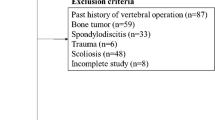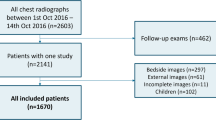Abstract
Objective
To compare the performances of artificial intelligence (AI) to those of radiologists in wrist fracture detection on radiographs.
Methods
This retrospective study included 637 patients (1917 radiographs) with wrist trauma between January 2017 and December 2019. The AI software used was a deep neuronal network algorithm. Ground truth was established by three senior musculoskeletal radiologists who compared the initial radiology reports (IRR) made by non-specialized radiologists, the results of AI, and the combination of AI and IRR (IR+AI)
Results
A total of 318 fractures were reported by the senior radiologists in 247 patients. Sensitivity of AI (83%; 95% CI: 78–87%) was significantly greater than that of IRR (76%; 95% CI: 70–81%) (p < 0.001). Specificities were similar for AI (96%; 95% CI: 93–97%) and for IRR (96%; 95% CI: 94–98%) (p = 0.80). The combination of AI+IRR had a significantly greater sensitivity (88%; 95% CI: 84–92%) compared to AI and IRR (p < 0.001) and a lower specificity (92%; 95% CI: 89–95%) (p < 0.001). The sensitivity for scaphoid fracture detection was acceptable for AI (84%) and IRR (80%) but poor for the detection of other carpal bones fracture (41% for AI and 26% for IRR).
Conclusions
Performance of AI in wrist fracture detection on radiographs is better than that of non-specialized radiologists. The combination of AI and radiologist’s analysis yields best performances.
Key Points
• Artificial intelligence has better performances for wrist fracture detection compared to non-expert radiologists in daily practice.
• Performance of artificial intelligence greatly differs depending on the anatomical area.
• Sensitivity of artificial intelligence for the detection of carpal bones fractures is 56%.






Similar content being viewed by others
Abbreviations
- AI:
-
Artificial intelligence
- CI:
-
Confidence interval
- CT:
-
Computed tomography
- IRR:
-
Initial radiology report
- MRI:
-
Magnetic resonance imaging
- MSK:
-
Musculoskeletal
- NPV:
-
Negative predictive value
- PPV:
-
Predictive positive value
References
OECD Health statistics (2015) In: European Society of Radiology. https://doi.org/10.1787/health-data-en. Accessed 27 Apr 2020
The Latest Emergency Department Utilization Numbers Are In. In: ACEP Now. https://www.acepnow.com/article/the-latest-emergency-department-utilization-numbers-are-in/. Accessed 27 Apr 2020
Kim DH, MacKinnon T (2018) Artificial intelligence in fracture detection: transfer learning from deep convolutional neural networks. Clin Radiol 73:439–445
Kalmet PHS, Sanduleanu S, Primakov S, Wu G, Jochems A, Refaee T, Ibrahim A, Hulst Lv, Lambin P, Poeze M (2020) Deep learning in fracture detection: a narrative review. Acta Orthop 91:215-
Leeper WR, Leeper TJ, Vogt KN, Charyk-Stewart T, Gray DK, Parry NG (2013) The role of trauma team leaders in missed injuries: does specialty matter? J Trauma Acute Care Surg 75:387–390
Nakaura T, Higaki T, Awai K, Ikeda O, Yamashita Y (2020) A primer for understanding radiology articles about machine learning and deep learning. Diagn Interv Imaging 101:765–770
Roca P, Attye A, Colas L et al (2020) Artificial intelligence to predict clinical disability in patients with multiple sclerosis using FLAIR MRI. Diagn Interv Imaging 101:795–802
Gulshan V, Peng L, Coram M et al (2016) Development and validation of a deep learning algorithm for detection of diabetic retinopathy in retinal fundus photographs. JAMA 316:2402–2410
Esteva A, Kuprel B, Novoa RA et al (2017) Dermatologist-level classification of skin cancer with deep neural networks. Nature 542:115–118
Sirinukunwattana K, Ahmed Raza SE, Tsang YW nul, Snead DRJ, Cree IA, Rajpoot NM (2016) Locality sensitive deep learning for detection and classification of nuclei in routine colon cancer histology images. IEEE Trans Med Imaging 35:1196–1206
Cireşan DC, Giusti A, Gambardella LM, Schmidhuber J (2013) Mitosis detection in breast cancer histology images with deep neural networks. Med Image Comput Comput Assist Interv 16:411–418
Ye J, Li Q, Nie J (2022) Prevalence, characteristics, and associated risk factors of wrist fractures in Americans above 50: the cross-sectional NHANES study. Front Endocrinol 13:800129
Curtis JR, Arora T, Matthews RS et al (2010) Is withholding osteoporosis medication after fracture sometimes rational? A comparison of the risk for second fracture versus death. J Am Med Dir Assoc 11:584–591
Lindsey R, Daluiski A, Chopra S et al (2018) Deep neural network improves fracture detection by clinicians. Proc Natl Acad Sci U S A 115:11591–11596
Gan K, Xu D, Lin Y et al (2019) Artificial intelligence detection of distal radius fractures: a comparison between the convolutional neural network and professional assessments. Acta Orthop 90:394–400
Chung SW, Han SS, Lee JW et al (2018) Automated detection and classification of the proximal humerus fracture by using deep learning algorithm. Acta Orthop 89:468–473
Adams M, Chen W, Holcdorf D, McCusker MW, Howe PD, Gaillard F (2019) Computer vs human: deep learning versus perceptual training for the detection of neck of femur fractures. J Med Imaging Radiat Oncol 63:27–32
Dupuis M, Delbos L, Veil R, Adamsbaum C (2022) External validation of a commercially available deep learning algorithm for fracture detection in children. Diagn Interv Imaging 103:151–159
Etli I, Kozaci N, Avci M, Karakoyun OF (2020) Comparison of the diagnostic accuracy of X-ray and computed tomography in patients with wrist injury. Injury 51:651-655
Dias JJ, Thompson J, Barton NJ, Gregg PJ (1990) Suspected scaphoid fractures: the value of radiographs. J Bone Joint Surg Br 72:98–101
Fowler JR, Hughes TB (2015) Scaphoid fractures. Clin Sports Med 34:37–50
Olczak J, Fahlberg N, Maki A et al (2017) Artificial intelligence for analyzing orthopedic trauma radiographs. Acta Orthop 88:581–586
Foufi V, Lanteri S, Gaudet-Blavignac C, Remy P, Montet X, Lovis C (2018) Automatic annotation tool to support supervised machine learning for scaphoid fracture detection. Stud Health Technol Inform 255:210–214
Yoon AP, Lee Y-L, Kane RL, Kuo C-F, Lin C, Chung KC (2021) Development and validation of a deep learning model using convolutional neural networks to identify scaphoid fractures in radiographs. JAMA Netw Open 4:e216096
Duron L, Ducarouge A, Gillibert A et al (2021) Assessment of an AI aid in detection of adult appendicular skeletal fractures by emergency physicians and radiologists: a multicenter cross-sectional diagnostic study. Radiology 300:120–129
Guermazi A, Tannoury C, Kompel AJ et al (2022) Improving radiographic fracture recognition performance and efficiency using artificial intelligence. Radiology 302:627–636
Welling RD, Jacobson JA, Jamadar DA, Chong S, Caoili EM, Jebson PJL (2008) MDCT and radiography of wrist fractures: radiographic sensitivity and fracture patterns. AJR Am J Roentgenol 190:10–16
Ozkaya E, Topal FE, Bulut T, Gursoy M, Ozuysal M, Karakaya Z (2022) Evaluation of an artificial intelligence system for diagnosing scaphoid fracture on direct radiography. Eur J Trauma Emerg Surg 48:585–592
Langerhuizen DWG, Bulstra AEJ, Janssen SJ et al (2020) Is deep learning on par with human observers for detection of radiographically visible and occult fractures of the scaphoid? Clin Orthop Relat Res 478:2653–2659
Yang T-H, Horng M-H, Li R-S, Sun Y-N (2022) Scaphoid fracture detection by using convolutional neural network. Diagnostics 12:895
Hendrix N, Scholten E, Vernhout B et al (2021) Development and validation of a convolutional neural network for automated detection of scaphoid fractures on conventional radiographs. Radiol Artif Intell 3:e200260
Berbaum KS, Franken EA, Dorfman DD et al (1990) Satisfaction of search in diagnostic radiology. Invest Radiol 25:133–140
Zhou QQ, Tang W, Wang J et al (2021) Automatic detection and classification of rib fractures based on patients’ CT images and clinical information via convolutional neural network. Eur Radiol 31:3815–3825
Funding
The authors state that this work has not received any funding.
Author information
Authors and Affiliations
Corresponding author
Ethics declarations
Guarantor
The scientific guarantor of this publication is Julien Puntonet.
Conflict of interest
The authors of this manuscript declare no relationships with any companies whose products or services may be related to the subject matter of the article.
Statistics and biometry
No complex statistical methods were necessary for this paper.
Informed consent
Written informed consent was waived by the Institutional Review Board.
Ethical approval
Institutional Review Board approval was obtained.
Methodology
• retrospective
• diagnostic study
• performed at one institution
Additional information
Publisher’s note
Springer Nature remains neutral with regard to jurisdictional claims in published maps and institutional affiliations.
Supplementary information
ESM 1
(DOCX 935 kb)
Rights and permissions
Springer Nature or its licensor (e.g. a society or other partner) holds exclusive rights to this article under a publishing agreement with the author(s) or other rightsholder(s); author self-archiving of the accepted manuscript version of this article is solely governed by the terms of such publishing agreement and applicable law.
About this article
Cite this article
Cohen, M., Puntonet, J., Sanchez, J. et al. Artificial intelligence vs. radiologist: accuracy of wrist fracture detection on radiographs. Eur Radiol 33, 3974–3983 (2023). https://doi.org/10.1007/s00330-022-09349-3
Received:
Revised:
Accepted:
Published:
Issue Date:
DOI: https://doi.org/10.1007/s00330-022-09349-3




